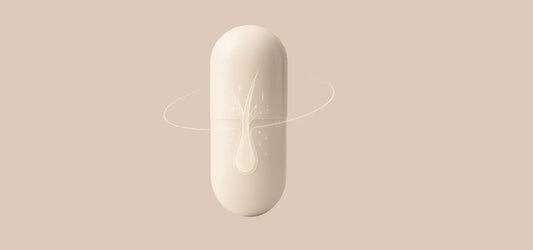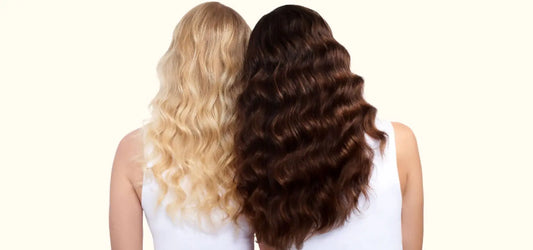The Top Science-Backed Treatments for Hair Loss

SHOP this article
OMI
Hair Growth Peptides Capsules
Promote stronger hair growth and scalp health with our unique peptide formula.
Hair loss. Two little words that can carry heavy emotional and psychological baggage. Millions are affected, yet the causes are diverse, ranging from hormonal changes and genetic predisposition to aging, stress, nutritional deficiencies, and environmental damage. Fortunately, the treatments for hair loss have dramatically expanded in recent years, moving beyond traditional pharmaceuticals into biologically advanced therapies. Among these, OMI Hair Growth Peptides have emerged as a next-generation solution with the potential to outshine even the most established options. Here, a closer look at the top choices backed by science:
The Conventional Champions: Minoxidil and Finasteride
Minoxidil: The FDA-Approved Pioneer
Minoxidil, the active ingredient in the well-known hair growth treatment Rogaine™, was originally developed to treat high blood pressure, but it had an unusual side effect: it promoted hair growth. This led to its rebranding as a topical solution for male and female pattern baldness, eventually receiving FDA approval. Minoxidil works primarily by acting as a vasodilator, increasing blood flow to the scalp and giving hair follicles a steady supply of nutrients and oxygen. Over time, all this extra circulation helps enlarge shrunken follicles which prolongs the anagen, or growth, phase of the hair cycle. Most users begin to see noticeable changes in hair growth within eight to sixteen weeks, with peak effects often occurring around the four-month mark.
Still, minoxidil has drawbacks. The hair growth benefits are temporary and require continuous use; once you stop taking the medication, hair typically returns to its previous thin and shedding state. Plus, there are side effects. Topical applications may cause scalp irritation, flaking, and even hair shedding, and oral minoxidil, while potentially more effective, carries additional systemic risks such as low blood pressure, rapid or irregular heartbeat, fluid retention, and in rare instances, more serious cardiac events. It’s also not recommended for women who are pregnant or breastfeeding, those under the age of 18, or anyone with unexplained hair loss, making it a limiting factor for anyone experiencing hair loss under these circumstances.
Finasteride: The Hormonal Gatekeeper
Another mainstream option is finasteride, an oral prescription medication designed for hair loss due to hormonal issues. Finasteride works by inhibiting an enzyme that converts testosterone into dihydrotestosterone, or DHT. DHT is known to miniaturize hair follicles in those who are genetically predisposed. By reducing DHT levels, finasteride can slow hair loss and even promote regrowth in many men. However, it’s not approved for use in women and is associated with sexual side effects, including decreased libido and erectile dysfunction. These side effects, although relatively rare, can deter long-term use.
Dutasteride: A Potent Alternative
Dutasteride works similarly to finasteride but packs a bigger punch. By inhibiting a second form of the enzyme that converts testosterone to DHT, it results in superior hair regrowth, but with even greater risk of the same side effects associated with Finasteride. It’s also not FDA-approved for hair loss treatment in the U.S., though it has received approval in South Korea and Japan.
Beyond Pharmaceuticals: Non-Drug Therapies
Low-Level Laser Therapy (LLLT)
This therapy uses light energy to stimulate cells within the hair follicles via devices such as laser helmets and combs. By using a specialized bio-light, mitochondria (energy centers within the cell) are activated to enhance blood flow and boost the delivery of nutrients. LLLT is especially effective in the early stages of hair loss, and it pairs well with other treatments. However, these devices can be pricey, and the time commitment, typically multiple sessions a week for many months, may be off-putting to some.
Platelet-Rich Plasma (PRP) Therapy
Platelet-rich plasma (PRP) therapy is another advanced approach that involves drawing the patient’s own blood, isolating the platelet-rich portion, and injecting it into the scalp. Platelets contain numerous growth factors that can stimulate and potentially awaken dormant follicles. PRP is considered safe since it uses the body’s own material, but it requires multiple sessions and is often quite expensive. The efficacy of PRP can also vary significantly based on health, age, and the quality of the plasma preparation.
Microneedling
Microneedling is a popular technique both as a standalone treatment and as a complement to topical applications. Fine needles are used to create micro-injuries on the scalp, which in turn triggers a healing response and the release of growth factors. Microneedling can also enhance the absorption of topical treatments like peptide serums and minoxidil. While generally safe, proper technique and hygiene are essential to avoid complications like infection or scarring.
Nutritional and Surgical Approaches
Nutritional Support
Nutrition is one of the foundations of healthy hair. Deficiencies in key hair growth vitamins and minerals such as biotin, zinc, vitamin D, and iron can exacerbate hair shedding and impede growth. It makes sense, then, that vitamins for hair growth can correct these deficiencies and support a healthy hair growth cycle, but this approach is most effective in those with a documented shortage, a condition that requires medical testing. Otherwise, taking supplements without a confirmed deficiency probably won’t do all that much, and can even cause harm if misused.
Stem Cell Therapy and Hair Transplant Surgery
More experimental therapies include stem cell treatments and the use of exosomes, molecules involved in cell communication. These treatments aim to regenerate damaged follicles and encourage new growth by leveraging the body’s innate repair mechanisms. While the results are promising, these therapies remain in the experimental stage and are often prohibitively expensive.
Hair transplant surgery remains the gold standard for permanent hair restoration in cases of advanced baldness. Techniques like follicular unit extraction (FUE) and follicular unit transplantation (FUT) involve relocating healthy follicles from one part of the scalp to another. The results can be life-changing, but the procedure involves surgical risks, recovery time, and considerable financial investment.
The Emerging Hero: Hair Growth Peptides
How Peptides Work
Amid this crowded field of treatments, peptides have emerged as a biologically smart and minimally invasive alternative. Peptides are short chains of amino acids that serve as the building blocks of proteins. In the context of hair restoration, specific peptides instruct follicles to grow, remain active longer, and resist damage from inflammation and oxidative stress. Unlike treatments that merely stimulate blood flow or suppress hormones, peptides work on multiple fronts to rejuvenate the entire scalp environment.
Key Peptides in Hair Restoration
One of the most studied peptides is GHK-Cu, a copper peptide known for its ability to jumpstart the formation of new blood vessels and enhance nutrient delivery to the hair follicles. GHK-Cu also boosts collagen production and neutralizes free radicals, thereby fortifying the scalp and slowing the aging process of follicles. Clinical studies have shown a 27 percent increase in hair density after six months of consistent use.
Another potent peptide is biotinoyl tripeptide-1, which enhances keratin production and improves the anchoring of hair fibers. Research has shown a 58 percent reduction in hair loss and a 35 percent increase in density among users. Acetyl tetrapeptide-3 focuses on strengthening the matrix, or “scaffolding” around follicles, resulting in better anchoring and reduced shedding. In clinical trials, this peptide increased hair diameter by 17 percent and overall growth activity by 67 percent.
BPC-157 is a regenerative peptide that aids in tissue repair and vascular health. It helps restore damaged follicles and reduces inflammation, making it ideal for those whose hair loss is associated with scalp damage or trauma. APN5, a newer entrant, mimics the hair growth effects of minoxidil but at a lower concentration, thereby reducing the risk of side effects.
Why OMI Hair Growth Peptides Stand Out
OMI Hair Growth Peptides distinguish themselves by combining the proprietary, patented IFP Hair Factor™, B-vitamins and key minerals into a single, bioavailable formulation. Designed to tackle the root causes of hair thinning and shedding, OMI peptides go beyond superficial fixes. They target the primary sources of hair health directly by improving follicle anchoring, extending the hair growth cycle, and fortifying the structure of the hair cortex. Suitable for both men and women, OMI peptides are free from hormonal manipulation and are compatible with other treatments like microneedling or LLLT. Importantly, they do not create dependency; users can maintain results with flexible dosing without experiencing rebound shedding.
During the 90-day clinical study, participants experienced 47% less shedding and overall improved hair health. Improved hair growth cycles and increased strand thickness become visible within three months. These timelines align with natural hair growth cycles, making OMI peptides a realistic and sustainable option.
The Takeaway
Hair loss is complex, and its treatment is often multifaceted. While traditional pharmaceuticals like minoxidil and finasteride offer valid solutions, their limitations and side effects highlight the need for safer, more holistic options. OMI Hair Growth Peptides are a significant leap forward in hair loss science. By addressing the biological, structural, and environmental factors that contribute to hair loss, OMI offers a comprehensive and side-effect-light alternative.
Frequently Asked Questions
1. What makes Hair Growth Peptides different from minoxidil or finasteride?
Hair growth peptides offer a biologically intelligent, multi-targeted approach to hair restoration. While minoxidil increases blood flow and finasteride blocks DHT, hair growth peptides stimulate the scalp’s natural regenerative powers by enhancing collagen production, reducing inflammation, improving circulation, and strengthening follicle anchoring.
2. How soon can I expect to see results from Hair Growth Peptides?
Most users notice reduced shedding and a healthier scalp within the first four to eight weeks of consistent use. Early regrowth and improved hair texture typically appear within two to three months, with fuller density and strand thickness by the fourth to sixth month.
3. Can I use Hair Growth Peptides with other hair loss treatments?
Yes, hair growth peptides are designed to be compatible with a variety of treatments. They can be safely combined with microneedling, low-level laser therapy (LLLT), topical minoxidil, and nutritional supplements.
4. Are there any side effects with Hair Growth Peptides?
Hair growth peptides are well-tolerated by most users and have a low risk of side effects. Because they don’t interfere with systemic hormones or cause vasodilation like some pharmaceuticals, users are less likely to experience irritation, dizziness, or unwanted hair growth on other parts of the body.
5. Who is an ideal candidate for Hair Growth Peptides?
Hair growth peptides are suitable for both men and women experiencing early to moderate hair thinning due to stress, hormonal shifts, aging, inflammation, or environmental damage. They are especially effective for people looking for a non-hormonal, side-effect-light solution, or for those who cannot tolerate minoxidil or finasteride.

 8 minutes
8 minutes







